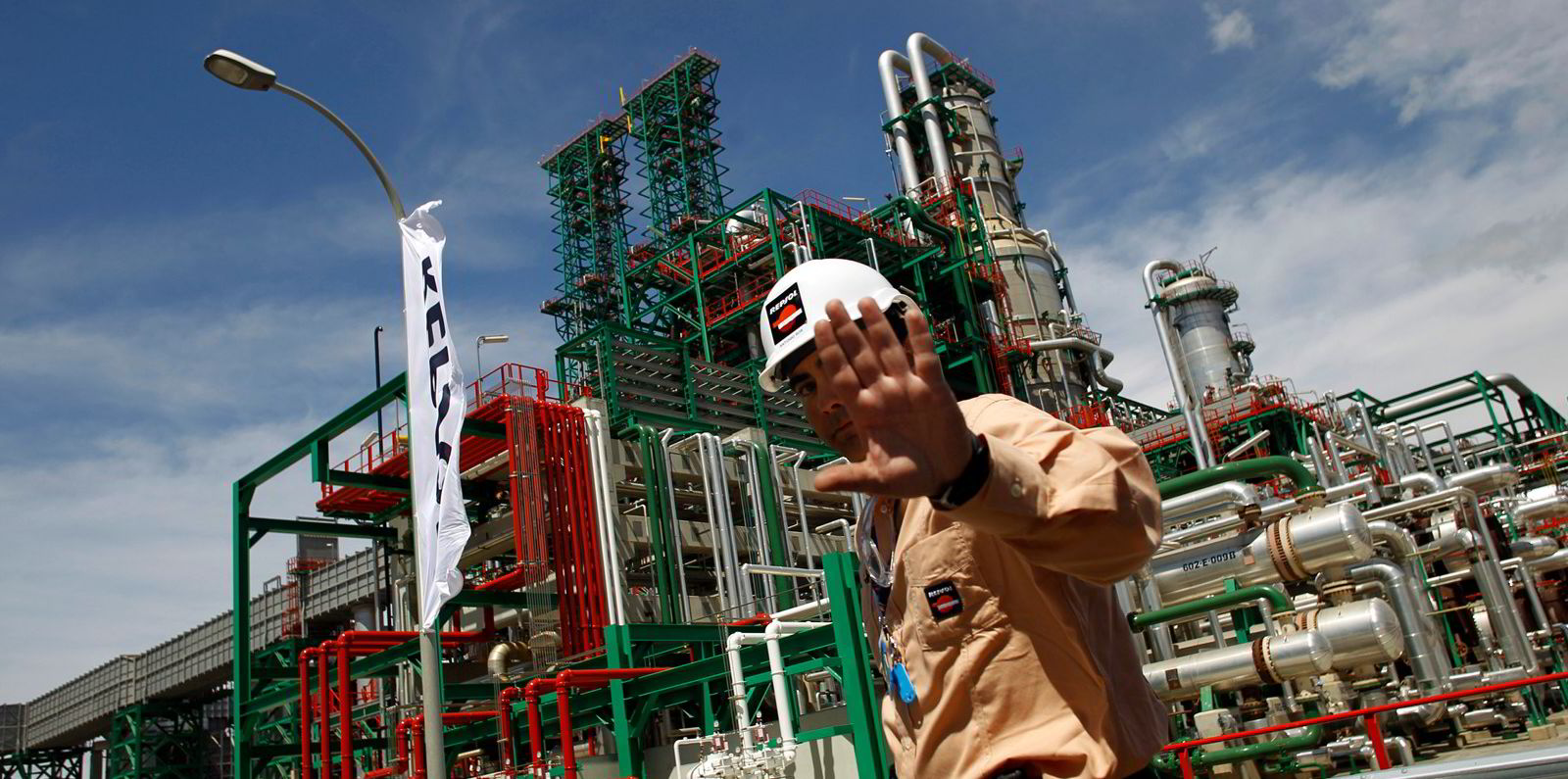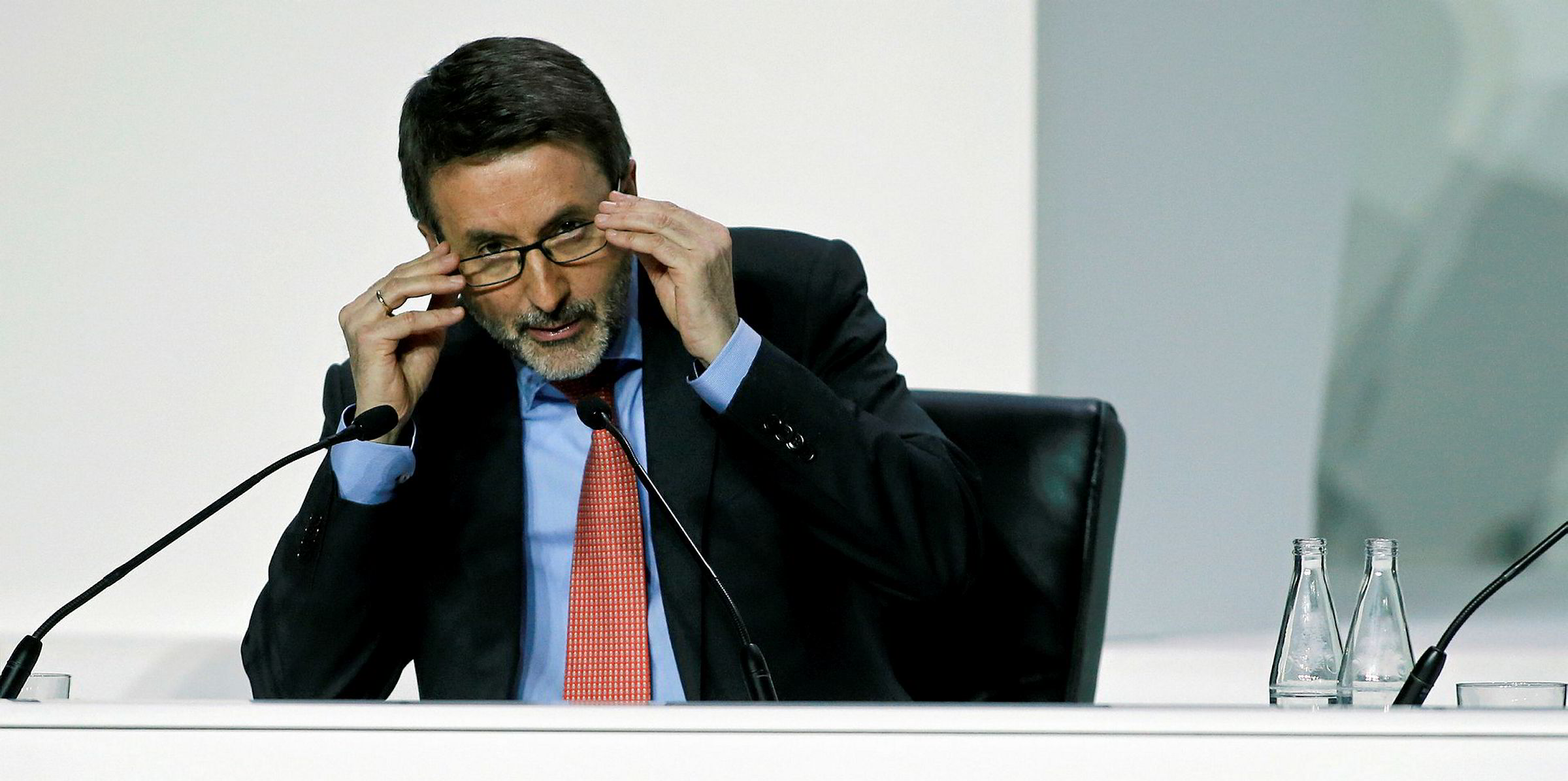
Democratic Gov. Michelle Lujan Grisham addresses energy executives at the New Mexico Oil And Gas Association meeting on Monday, Oct. 4, 2021, in Santa Fe, New Mexico. Lujan Grisham has moved to crack down on pollution from gas extraction while also trying to shield the state's producers from a drilling moratorium by the Biden administration. New Mexico relies on oil and gas royalties for around one third of its budget.
SANTA FE, N.M. (AP) — A coalition of environmental groups are raising concerns about Gov. Michelle Lujan Grisham’s plans to turn New Mexico into a hydrogen fuel hub.
The Democrat, who is running for reelection, has set a goal of reducing greenhouse gas emissions at least 45% by 2030 as compared to 2005 levels.
The Natural Resource Defense Council, the Rio Grande Chapter of the Sierra Club, the New Mexico Environmental Law Center and two dozen other organizations argue in a letter sent Tuesday to the governor and other top elected officials that large-scale development of hydrogen risks incentivizing new oil and natural gas fields.
Hydrogen fuel cells can power vehicles to reduce transportation emissions, but most energy used to produce hydrogen comes from natural gas. Some are hopeful that hydrogen can be produced by using electricity generated from solar or wind power to separate hydrogen and oxygen in water.
However, the letter warns of excessive water use in a state where the commodity is already scarce.
The groups urged the governor to focus on wind and solar energy instead.
Lujan Grisham has expressed interest in speaking at a climate change conference next month. Earlier this year, she asked Biden to exempt oil and gas producers in New Mexico from a drilling moratorium.
In a speech this week to oil and gas executives, Lujan Grisham invited them to join her in partnerships for hydrogen production in the coming decades.
The U.S. Energy Department in July allocated more than $50 million to a number of projects in support of the agency’s hydrogen initiative.
___
Attanasio is a corps member for the Associated Press/Report for America Statehouse News Initiative. Report for America is a nonprofit national service program that places journalists in local newsrooms to report on under-covered issues. Follow Attanasio on Twitter.
Reuters | October 4, 2021

Andrew Forrest founded Fortescue Metals Group in 2003.
The world needs to focus on absolute zero emissions, rather than a net zero target, and use clean hydrogen to get there rather than relying on unproven technologies such as carbon capture and storage, Australian iron ore titan Andrew Forrest said on Monday.

Forrest, who grew Fortescue Metals Group into the world’s fourth largest iron ore miner in less than two decades, has turned his attention to developing green energy projects such as hydrogen around the world.
Australia’s richest man said the idea of reaching “net zero” by 2050 – a pillar of the upcoming COP26 climate summit in Glasgow – was a “smokescreen” that suggested climate change could be solved by burying or offsetting carbon emissions.
“It’s not going to happen,” said Forrest, speaking on a panel at the Reuters Impact conference.
“The fossil fuel industry has lobbied hard… to get taxpayers to fund their attempt at a transition to ‘clean’ energy – on their timetable. But that’s a highway to climate disaster.”
Of the 60 million tonnes of hydrogen produced every year, 96% was still made from fossil fuels, Forrest said.
“Green hydrogen is the solution we need to get to absolute zero,” he said.
Green hydrogen is made from water, using renewable electricity, while other sorts such as “blue” hydrogen are produced from fossil fuels.
The International Energy Agency backed a bigger role for hydrogen on Monday, saying governments needed to step up investment in hydrogen production and storage chains to help cut net emissions to zero.
The Australian government is pushing both hydrogen development and carbon capture and storage (CCS) to cut emissions, as it views CCS as essential to the future use of gas and coal, the country’s second- and third-largest export earners.
But the 20 pilot CCS plants in existence worldwide capture only 0.4% of the CO2 emitted globally by power stations and industrial processes, Forrest said.
To meet a net zero emissions target by 2050, the IEA projects the world would need to capture and store 7.6 billion tonnes a year of carbon dioxide by 2050, up from current CCS capacity of 40 million tonnes a year.
“Carbon capture and storage, despite having received billions of subsidies for decades, remains an unproven failure, far from commercial viability,” said Forrest.
(By Melanie Burton and Sonali Paul; Editing by Alex Richardson)
Wed, October 6, 2021

FILE PHOTO: Photo of the logo of Fortescue Metals Group adorning their headquarters in Perth, Australia
In
(Reuters) - Fortescue Metals Group Ltd's green energy unit said on Thursday it bought a 60% stake in Dutch-based renewable firm High yield Energy Technologies (HyET) Group in a bid to cut costs and boost green energy production.
Fortescue Future Industries (FFI) is part of Fortescue Metals' plan to become the world's first major supplier of green iron ore, and aims to supply 15 million tonnes of green hydrogen globally by 2030.
Fortescue Metals, the world's No.4 iron ore producer, is pursuing some of the most ambitious green plans in the industry with its efforts to diversify into renewable energy and green hydrogen through FFI.
"HyET Hydrogen's technology will support FFI in reducing costs in other areas of the green hydrogen supply chain," said Julie Shuttleworth, chief executive officer of FFI.
FFI, which plans to spend between $400 million and $600 million in the year to June 2022 on developing green transport and decarbonisation technologies, expects to cut down costs at its Powerfoil factory in Australia from the acquisition.
As part of the deal, FFI will provide a majority share of financing for the expansion of HyET Solar's Dutch Solar photovoltaics factory. Financial terms of the stake acquisition were not disclosed.
(Reporting by Tejaswi Marthi in Bengaluru; Editing by Subhranshu Sahu)
Spanish giant claims its first 10-tonne batch of renewable hydrogen offset roughly 90 tonnes of CO2 emissions

Producing renewable hydrogen: Repsol's refinery in Cartagena, Spain
By Josh Lewis in Perth
Spanish oil and gas giant Repsol has produced its first batch of hydrogen utilising biomethane as the feedstock.
Repsol confirmed Monday it had produced 10 tonnes of renewable hydrogen at its Cartagena Industrial Complex, in the Murcia region of south-east Spain.
The hydrogen produced from the process will be used to manufacture fuels such as gasoline, diesel, or kerosene for aviation.
By utilising the equivalent of 500 megawatt hours of biomethane to produce the hydrogen, Repsol claims it avoided roughly 90 tonnes of carbon dioxide emissions.
“This new process for production of renewable hydrogen is further evidence of the transformation of Repsol’s industrial complexes into multi-energy hubs capable of manufacturing decarbonized products. It also supports the company’s commitment to achieving zero net emissions by 2050,” Repsol said in Monday’s statement.

Repsol aims to produce hydrogen directly from solar
“Energy efficiency, circular economy, renewable hydrogen, and CO2 capture and use technologies are the four main pillars on which Repsol is based to place its industrial complexes at the forefront of the energy transition.”
The milestone comes after Repsol in August claimed to have produced Spain’s first aviation biofuel from waste at its Petronor Industrial Complex in Bilbao.
It claimed the 5300-tonne batch of biojet would help avoid 300 tonnes of CO2, roughly the equivalent emitted from 40 flights between Madrid and Bilbao.
Repsol is also planning to start up a 2.5-megawatt electrolyser at its Petronor refinery in the second half of next year to produce green hydrogen, while it is aiming to have 1.9 gigawatts of installed capacity across its portfolio by 2030.
CALGARY, Alberta – Canadian Pacific has shared an image of its forthcoming hydrogen-powered locomotive. It shows an EMD cowl-style locomotive in a green, blue, white, and gray paint scheme.
According to the railroad’s sustainability website, the locomotive, known as “H2 0EL” for Hydrogen – Zero Emissions Locomotive, will be prepped for its official painting and launch. Each design element of the locomotive articulates the effect of this project. The blue and green paint colors represent sustainability, water, and technology. The H2 0EL wordmark features angled typography to symbolize movement and progress in action.
“This is a globally significant project that positions CP at the leading edge of decarbonizing the freight transportation sector,” President and CEO Keith Creel says. “CP will continue to focus on finding innovative solutions to transform our operations and implement our Climate Strategy, positioning CP and our industry as leaders for a sustainable future.”
CP has previously tested lower-emission locomotives using biofuels and compressed natural gas, as well as battery-powered units. Virtually all freight locomotives in North America are diesel-powered, representing railroading’s most significant source of greenhouse gas emissions.
The railroad expects the unit to begin operation in 2022.
Silicon-Carbide Nanotubes: New Study Reveals Relations Between Hydrogen and Its Storage, Bringing the Energy Into Daily Use
Hydrogen energy is potentially a key measure to meet the United Nations net zero emissions target, although the hardship in handling and storage has stalled its industrial function.
A Phys.org report specified that a gas, at a very low -252 degrees Celsius, making its storage at room temperature quite a challenge.
Essentially, the relations between hydrogen and its storage material is merely very weak to carry on at room temperature. This makes the design of the storage materials essential to reaching the goal of bringing hydrogen energy into everyday use.
This is where computational material design arises. Too much time and energy can be saved during the hydrogen technology development by designing a material using a computer and mimicking its capacity for hydrogen storage.
Van Der Waals Force
The predictions, nonetheless, become quite limited in their use unless they are precise and can be made at a reasonable estimated cost.
In recent research published in ACS Omega, researchers developed a computationally costly, although precisely novel, way to forecast hydrogen storage.
According to the study's lead, the Japan Advanced Institute of Science and Technology's Dr. Kenta Hongo, improving prediction dependability for simulations can help fast-track the development of materials for hydrogen fuel storage and result in a more energy-saving society.
One of the essential forces of attraction between things is the van der Waals force, defining the interaction between molecules or atoms based on the distance between them.
Since this said force is the result of a quite complex quantum process, conventional solutions could not explain it very well, and therefore, the simulations thus far are the level of rough approximations of it.
Silicon-Carbide Nanotubes
To answer the question on the appropriateness of this approach, Dr. Hongo and his team looked at silicon-carbide nanotubes, one of the most capable materials for hydrogen storage.
A similar My Space Astronomy report said, with a computational approach known as diffusion Monte Carlo or DMC, the team devised a model that accounted for the van der Waals forces when mimicking the hydrogen storage in silicon-carbide nanotubes.
Most conventional models consider the connections between the said nanotube materials and hydrogen. Although, the DMC approach utilizes the power of a supercomputer to reconstruct the interaction mechanism by following the individual electrons' arrangement.
This makes the DMC prototype the most precise approach of forecast to date. The scientists were also able to forecast the amount of energy needed to dislodge hydrogen from its storage and the distance the hydrogen was likely to be from the silicon-carbide nanotube's surface.
They then compared the results from their modeling to those obtained via conventional prediction methods. Dr. Hongo believes that such findings can be a stepping stone for further hydrogen storage simulation tech improvement.
He added that even though the DMC approach is computationally costly, it can be used to clarify the peculiarities, or the tendencies of prediction error, of every forecast method.
This will help understand which forecast is trustworthy and how to alter prediction methods to make them more helpful or functional.
Related information about Silicon-Carbide Nanotubes is shown on Subject Zero Science's YouTube video below:

FMG is boosting hydrogen and green energy production to cut its carbon footprint.
Fortescue Metals Group (ASX: FMG), the world’s fourth largest iron ore producer, became on Tuesday the first major miner to commit to achieving net zero scope 3 emissions, those produced by its customers including steel makers, by 2040.

The Australian miner put its closest rivals BHP, Rio Tinto and Vale under scrutiny earlier this year after announcing it had brought forward a self-imposed deadline of reaching net zero scope 1 and 2 emissions by 2030. That’s about two decades earlier than the other three iron ore producers.
Fortescue is seeking to move from being a major consumer of fossil fuel, with a current trajectory of more than 1 billion litres a year of diesel being used across the operations if no remedial action is taken, to a major clean and renewable energy exporter.
As part of that plan, it has also announced it aims to start producing green hydrogen as soon as 2023. The company is targeting the production of 15 million tonnes of green hydrogen a year by 2030, which will open up opportunities to work with customers and shipping partners on emissions reduction and elimination projects.
For now, the main customers FMG plans to work with are the one in the steelmaking sector, which account for 98% of the company’s scope 3 emissions.
To hit net-zero, the miner wants to reduce emission intensity levels from those customers by 7.5% by 2030.
Highway to climate disaster
Despite the commitment to eliminate emissions, FMG’s founder and main shareholder Andrew Forrester believes that the global goal of reaching “net zero” by 2050 – a pillar of the upcoming COP26 climate summit in Glasgow – is a “smokescreen.”
It suggests climate change could be solved by burying or offsetting carbon emissions, said Forrest, speaking on a panel at the Reuters Impact conference on Monday.
“The fossil fuel industry has lobbied hard… to get taxpayers to fund their attempt at a transition to ‘clean’ energy – on their timetable. But that’s a highway to climate disaster.”
Of the 60 million tonnes of hydrogen produced every year, 96% is still made from fossil fuels, Forrest noted. He added the solution to get to absolute zero emissions is green oxygen.
Mining magnate and Australia’s former prime minister Malcolm Turnbull launched last month a new body – the Green Hydrogen Organization – which will advocate for the country’s hydrogen industry to focus solely on green hydrogen produced from renewable sources.
Fortescue plans to use its own hydrogen from Fortescue Future Industries (FFI) to help transition its ore carrier fleet and help reduce or eliminate emissions in its partnerships.
The mining company will also use FFI’s hydrogen as it researches ways to produce iron ore and cement without the need for high temperatures and coal.
“Our work to decarbonise FMG’s iron ore operations will position Fortescue as the first major supplier of green iron ore in the world, paving the way for production of green iron and a new green steel industry,” FFI chief executive officer, Julie Shuttleworth, said in the statement.
Bold and welcome
Australasian Centre for Corporate Responsibility’s Director of Climate & Environment, Dan Gocher, said in an emailed statement that FMG’s announcement today was a “bold and welcome commitment.”
“FMG’s bold target overshadows the lack of ambition by BHP and Rio Tinto, whose absence of firm targets for steelmaking is looking increasingly lacklustre,” he said.
“BHP and Rio Tinto should be embarrassed by being outdone by a company they once referred to as a ‘junior miner’. It’s time for BHP and Rio Tinto to set binding targets for their scope 3 emissions, rather than simply funding research and working with their customers.”
Gocher believes that FMG’s news are “particularly humiliating” for BHP, given proxy advisors have recommended shareholders vote against the company’s climate transition plan at its upcoming annual general meetings. They are scheduled for October 14 in London and November 11 in Perth.










:no_upscale()/cdn.vox-cdn.com/uploads/chorus_asset/file/22893275/Nuclear_units_US_chorus.jpeg)
:no_upscale()/cdn.vox-cdn.com/uploads/chorus_asset/file/22893537/Electricity_sources_world_chorus.jpeg)